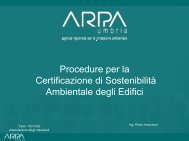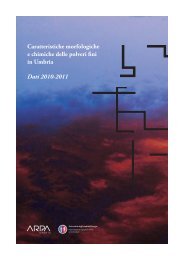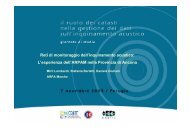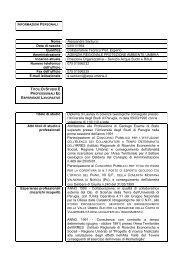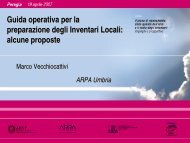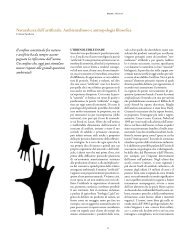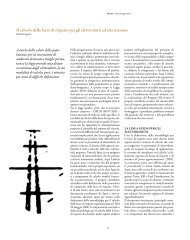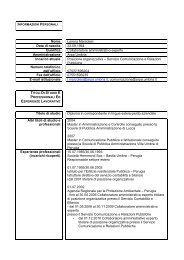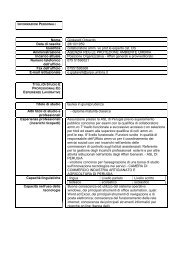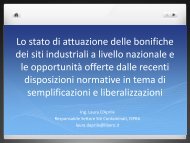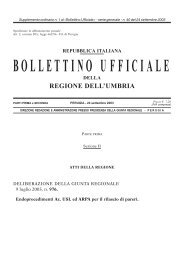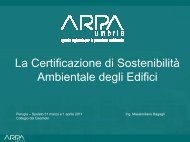Tutela ambientale del Lago Trasimeno - ARPA Umbria
Tutela ambientale del Lago Trasimeno - ARPA Umbria
Tutela ambientale del Lago Trasimeno - ARPA Umbria
You also want an ePaper? Increase the reach of your titles
YUMPU automatically turns print PDFs into web optimized ePapers that Google loves.
8 8 A r p a U m b r i a 2 0 1 2<br />
evidenziare le variazioni subite dalla<br />
flora idrofitica nel corso degli anni. La<br />
comunità macrofitica, ampiamente diffusa<br />
da riva al centro lago, è dominata da<br />
specie sommerse tipiche di ambienti con<br />
valori di trofia medio-alti. La scomparsa<br />
di alcune idrofite natanti e radicanti<br />
con foglie natanti è dovuta soprattutto<br />
alla riduzione di habitat idonei a causa<br />
di artificializzazione <strong>del</strong>le sponde,<br />
bonifica idraulica, regressione e interramento<br />
<strong>del</strong> canneto. L’eutrofizzazione<br />
<strong>del</strong>le acque sembra aver svolto, invece,<br />
un ruolo secondario nella riduzione<br />
dei taxa, avendo, la quasi totalità <strong>del</strong>le<br />
specie non più rilevate o poco diffuse,<br />
caratteristiche trofiche <strong>del</strong> tutto simili<br />
a quelle tuttora presenti e abbondanti.<br />
Un importante ruolo ecologico nell’area<br />
sud <strong>del</strong> lago è svolto dai popolamenti di<br />
Characeae.<br />
Il declino (die-back) <strong>del</strong>la cannuccia di<br />
palude è un fenomeno noto in Europa<br />
Centrale da alcuni decenni. Una ricerca<br />
sviluppata negli ultimi 5 anni ha consentito<br />
di rinvenire la presenza di marcati<br />
sintomi di moria, riconducibili alla<br />
sindrome di die-back, anche nel canneto<br />
<strong>del</strong> lago <strong>Trasimeno</strong>, uno dei maggiori<br />
ecosistemi d’acqua dolce <strong>del</strong>la penisola<br />
italiana. Le indagini si sono basate sulla<br />
misurazione di parametri di popolazione,<br />
morfologici e fenologici, su individui<br />
di Phragmites australis all’interno<br />
di 19 quadrati permanenti ubicati in<br />
diverse aree lungo le sponde <strong>del</strong> lago,<br />
con l’obiettivo di mettere a confronto<br />
le caratteristiche <strong>del</strong> canneto in condizioni<br />
ecologiche note. Lo studio, oltre<br />
a fornire indicazioni metodologiche<br />
sui parametri più appropriati nella diagnosi<br />
<strong>del</strong> fenomeno, evidenzia come sia<br />
già avvenuta una drastica riduzione di<br />
un ecosistema di grande rilevanza nella<br />
conservazione <strong>del</strong>la biodiversità.<br />
community, abundant from the shore<br />
to the centre of the lake, is dominated<br />
by submerged species typical of environments<br />
with medium-high eutrophication.<br />
The disappearance of some floating<br />
hydrophytes and rooted hydrophytes<br />
with floating leaves is due above all to the<br />
reduction of suitable habitats because of<br />
the creation of artificial shoreland, water<br />
drainage, and regression and burying of<br />
the reed bed.<br />
Eutrophication of the waters seems<br />
only to have played a secondary role in<br />
reduction of the taxa, as nearly all of<br />
the species which are uncommon or no<br />
longer present have trophic characteristics<br />
no different from the species still<br />
abundant today. Characeae populations<br />
play an important role in the ecology of<br />
the southern part of the lake.<br />
Common reed die-back is a wi<strong>del</strong>y<br />
investigated phenomenon in central<br />
Europe and has been so for some decades.<br />
A study carried out during the last<br />
5 years has led to the detection of marked<br />
signs of blight which can be ascribed to<br />
the die-back syndrome, in the reed bed<br />
of Lake <strong>Trasimeno</strong> too, which hosts one<br />
of the largest freshwater ecosystems in<br />
Italy.<br />
The study was based on the measurement<br />
of morphological and phenological<br />
parameters of example populations<br />
of Phragmites australis in 19 permanent<br />
plots located in different areas along the<br />
lake shores. The aim of the study was to<br />
compare the characteristics of the reed<br />
beds under known and differing ecological<br />
conditions. The study not only provides<br />
an indication of the most appropriate<br />
parameters to use in the diagnosis<br />
of the die-back syndrome, but the results<br />
also show an already drastic reduction of<br />
an ecosystem with a very important role<br />
in biodiversity conservation.



